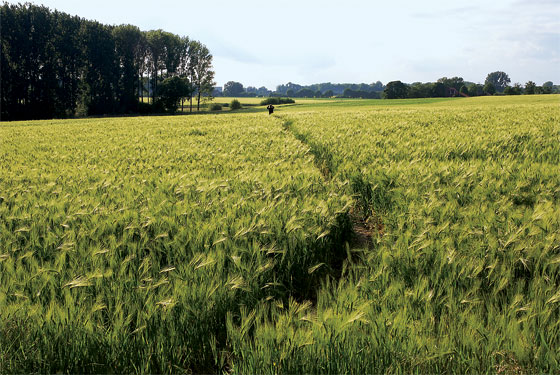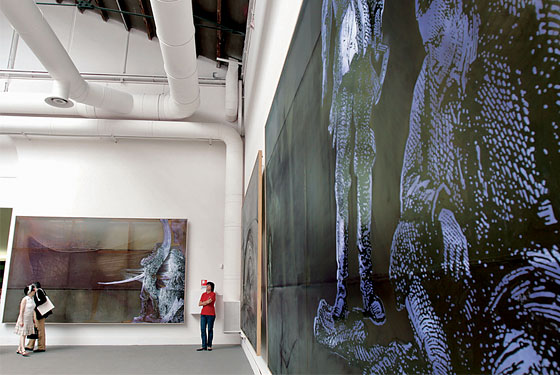
The alchemy of good curating amounts to this: Sometimes, placing one work of art near another makes one plus one equal three. Two artworks arranged alchemically leave each intact, transform both, and create a third thing. It’s uncanny, and this uncanniness occurs to varying degrees in the season’s three leviathan megaexhibitions. They are, of course, the Venice Biennale, Documenta XII, and Sculpture Projects Münster. As I wrote in our previous issue, I skipped the frenzied opening blowouts; a famous woman artist I know calls these shindigs “proms where the rich, powerful, and middle-aged get to cop a feel from young artists who paint themselves up like Jodie Foster in Taxi Driver.” Though I like openings and missed the schmoozing, seeing the shows in peace created a wonderfully charged space for doubt, ambiguity, and rumination. In Venice, I had whole pavilions to myself; Documenta hummed but was low-key; Münster returned to being a small German city with tens of thousands of bicyclists.
What did I determine, other than that I need to improve my left-turn biking etiquette? For one thing, Venice’s custom of divvying up pavilions by nation-state is a nineteenth-century relic. (Pavilions should be given to hip young curators from wherever, to do shows divorced from nationalism.) Also, there are now so many biennials that art is suffering from overexposure, and we do curators and artists a disservice by seeing these shows only at the openings. More than that, though, I found that each of the three super-shows offers a snapshot of the strategies and styles of those professionals who have been called “the men in black.” I’m talking, of course, about the curators.
The organizer of the 52nd Venice Biennale is Robert Storr, who in his years in the art world has worn many hats. (I’ve known him for decades; he used to let me sit in on his excellent lectures.) From 1990 to 2002, he was a curator at MoMA, then a professor at the Institute of Fine Arts at NYU; he’s always been an artist and is now the dean of the Yale School of Art, a consulting curator at the Philadelphia Museum of Art, and a contributor to several art magazines. Storr is a well-known supporter of such artists as Bruce Nauman, Sigmar Polke, Gerhard Richter, Robert Ryman, Louise Bourgeois, Ellsworth Kelly, Sol LeWitt, Susan Rothenberg, Jenny Holzer, Giovanni Anselmo, and Elizabeth Murray, as well as Ilya and Emilia Kabakov, Thomas Nozkowski, and Nancy Spero, every one of whom is in his show. His résumé is impressive. In some ways, this Biennale is his résumé.
Storr’s exhibition is titled “Think With the Senses—Feel With the Mind. Art in the Present Tense.” The “Think … Feel” part of the title presupposes that a mind-body split exists in the art world. There may have been one a while back, when theory and academicism were becoming monolithic. But this dichotomy feels false now. Most would agree with philosopher Mary Midgley, who wrote, “All reasoning is powered by feeling and all serious feeling has some reasoning in its skeleton. Thought and feeling are not opponents.” Yet the installation re-creates that very bifurcation. Almost all of Storr’s A-listers, and much of the painting, is displayed in the airy Italian pavilion at the center of the grounds, whereas most of the lesser-known conceptualists and photo-based artists are placed in the quarter-mile-long Arsenale.
As elegant and uncluttered as it is, and even though many of Storr’s regulars really shine, “Think—Feel” is a decorous, antiseptic, strangely straitjacketed affair. The Italian pavilion begins with Nancy Spero’s chilling Apocalypse Now–ish maypole of cutout heads. Two rooms later are the knockout quasi-abstract paintings by that old magician-artist Sigmar Polke. Nearby are six electrifying new Richters, followed by a room of Nauman’s horrifying face-shaped fountains, then galleries of Ryman, Kelly, and Anselmo. Not far off are rooms of riveting videos by Kara Walker, Steve McQueen, and newcomer Joshua Mosley.
Much of this work is compelling and poetic. But often, there’s an accumulation of thought (in Storr’s version of shock and awe) with little curatorial alchemy or skin-on-skin sensuousness between works. Indeed, Storr seems to have abstained altogether from mounting one of the ball-busting, conjectural, venturesome whales we call biennials. Instead, he mustered his big guns, stayed faithful to his BFFs, showcased some new names, and presents something like a mainstream museum survey. Some critics may have called “Think—Feel” anti-market, but the Italian pavilion is so packed with blue-chip artists that it often resembles the home of a very wealthy collector. It’s classic rock or power chords, a firing of the canon.
Everyone agrees with Storr’s stated argument for the “present tense,” of selecting artists regardless of age, reputation, or hype, and I love many of the artists he does; they’re my peeps, too. Even so, if I were in my twenties or thirties, or even (alas) my forties, I can imagine being impressed but also a bit let down and oppressed by it. I’d wonder if this wasn’t partly history being told from the point of view of the victors—a business-as-usual shoring-up rather than research into the mix and morphology of the moment. As Glenn O’Brien observed about German painter Albert Oehlen, who would have added something to this show, “There’s only one right way [to do something] but [Oehlen explores] a million brilliant errors.” Those brilliant errors are missing here.

In the Arsenale, Storr adopts a gambit I call “Curator As Anchorman.” Here, a curator in effect says, “Whenever there’s a problem in the world, I’ll be there.” Thus, we get photos of border guards, cemeteries, soldiers, slums, prisons, and refugees. Some of this work is okay. Most of it is overliteral. Several artists transcend the newsroom approach, especially Yang Zhenzhong, who’s showing a ten-screen video in which strangers look into his camera and say, “I will die.” This formally derivative but effective piece demonstrates that all types of certainty, be they curatorial, political, philosophical, or religious, will be undone by life in the end.
Speaking of which, there’s Documenta XII, in Kassel, Germany. English critics have called it “the worst art show ever” and “a disaster,” and this five-building, 150-artist, 19 million–euro extravaganza is flawed, haughty, despotic, and ego-tripping. Yet it does pose a polemic, which is one thing these cattle calls are good for. It’s too bad, then, that the husband-and-wife organizers, Roger M. Buergel and Ruth Noack, so relentlessly control their idea that the show turns arrogant and dogmatic.
Composed mainly of conceptual, political, and quasi-formal work, much of it unfamiliar art from the late sixties and seventies, Documenta XII is a manifesto of the good, the bad, the overlooked, and the annoyingly academic. As at the two previous Documentas, the curators propose that when history is viewed from a non-mainstream angle, “otherness” will become a relative term. I will say that the show made me look at work that I don’t like in new ways, and for that I liked it, albeit with serious misgivings. Venice and Documenta are opposites: Venice is a show peppered with interesting art that isn’t really a biennial; Documenta is a semi-interesting biennial-type show composed mainly of so-so work. Both are exercises in extreme organization.
Sculpture Projects Münster, by contrast, is an exercise in organized chaos, like a late Fellini film. This once-a-decade outdoor show is organized by Brigitte Franzen and the brilliant, legendary German curator Kasper König, who stir things up the old-fashioned way: They invite artists to Münster, give each a bicycle and a map, and instruct each to pick a site and make a proposal. Then he and his amazing staff allow things to unfold as they will.
The resultant 35-artist show is uneven, of course. Among many standouts, however, are Dominique Gonzalez-Foerster’s petting-zoo-like installation of scaled-down works of other Münster artists, Mike Kelley’s actual petting zoo, Hans-Peter Feldmann’s sprucing up of two public restrooms, Guy Ben-Ner’s reconstructed bicycle project, Susan Philipsz’s haunting recorded aria under a bridge, and Pawel Althamer’s winding path through parks and fields. On this path to nowhere, quiet moments vie with anxiety, delivering the kind of friction and frisson these giant shows have the power to produce and demonstrating why they’re far from obsolete. If curators can embrace alchemy and uncertainty, they can turn these super-slick megaevents into zones of aberration, maps of the present, theaters of doubt, and palimpsests of perception. They can still produce pleasure, tension, surprise, and revelation.
Venice Biennale
Through November 21.
Documenta XII
Through September 23.
Sculpture Projects Münster
Through September 30.
E-mail: jerry_saltz@newyorkmag.com.